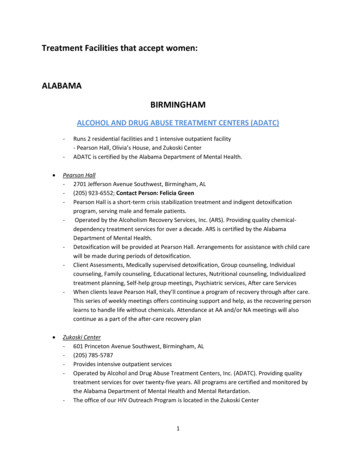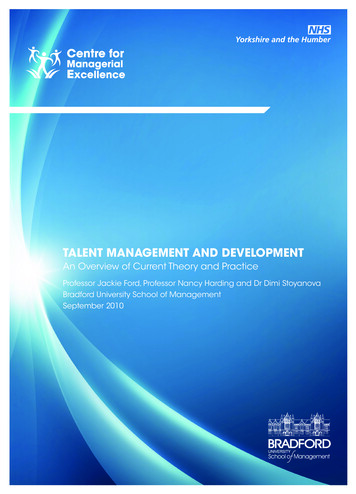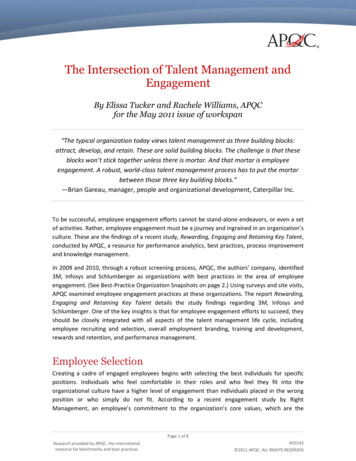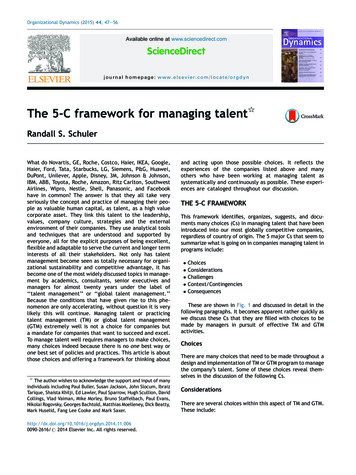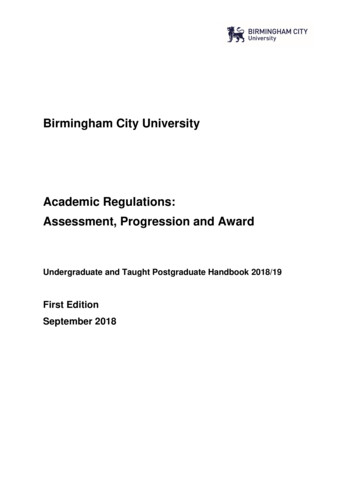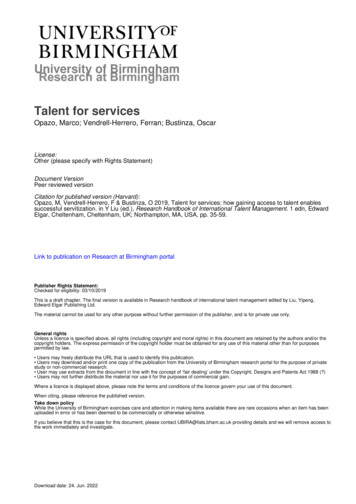
Transcription
University of BirminghamTalent for servicesOpazo, Marco; Vendrell-Herrero, Ferran; Bustinza, OscarLicense:Other (please specify with Rights Statement)Document VersionPeer reviewed versionCitation for published version (Harvard):Opazo, M, Vendrell-Herrero, F & Bustinza, O 2019, Talent for services: how gaining access to talent enablessuccessful servitization. in Y Liu (ed.), Research Handbook of International Talent Management. 1 edn, EdwardElgar, Cheltenham, Cheltenham, UK; Northampton, MA, USA, pp. 35-59.Link to publication on Research at Birmingham portalPublisher Rights Statement:Checked for eligibility: 03/10/2019This is a draft chapter. The final version is available in Research handbook of international talent management edited by Liu, Yipeng,Edward Elgar Publishing Ltd.The material cannot be used for any other purpose without further permission of the publisher, and is for private use only.General rightsUnless a licence is specified above, all rights (including copyright and moral rights) in this document are retained by the authors and/or thecopyright holders. The express permission of the copyright holder must be obtained for any use of this material other than for purposespermitted by law. Users may freely distribute the URL that is used to identify this publication. Users may download and/or print one copy of the publication from the University of Birmingham research portal for the purpose of privatestudy or non-commercial research. User may use extracts from the document in line with the concept of ‘fair dealing’ under the Copyright, Designs and Patents Act 1988 (?) Users may not further distribute the material nor use it for the purposes of commercial gain.Where a licence is displayed above, please note the terms and conditions of the licence govern your use of this document.When citing, please reference the published version.Take down policyWhile the University of Birmingham exercises care and attention in making items available there are rare occasions when an item has beenuploaded in error or has been deemed to be commercially or otherwise sensitive.If you believe that this is the case for this document, please contact UBIRA@lists.bham.ac.uk providing details and we will remove access tothe work immediately and investigate.Download date: 24. Jun. 2022
This is the author’s version of the book chapter “Talent for services: How gaining access totalent enables successful servitisation” accepted for publication in the book “ResearchHandbook of International Talent Management” edited by Prof. Yipeng Liu (Henley BusinessSchool) and commissioned by Edward Elgar.Title: Talent for services: How gaining access to talent enables successful servitisationAuthors: Marco Opazo-Basáez (University of Deusto, Spain)Ferran Vendrell-Herrero (University of Birmingham, UK)Oscar F. Bustinza (University of Granada, Spain)Abstract:Talent management has become a critical component of competitiveness and animportant factor in an organisation's global business success. It has been traditionallydeemed to be the sum of activities that specifically support a company’s strategicinitiatives. However, most of the extant literature on the subject to date has been largelyfocused on methods for attracting talent and retaining it within an organisation, failingto recognise the importance of ‘accessing’ talent. This is a barrier that can limit thesupply of skills and competences demanded in the marketplace, and is a fundamentalfactor in a firm s strategic performance. This chapter quantitatively tests a company’sability to ‘access’ qualified talent and how this affects its strategic orientation. Thestudy focuses on servitisation in manufacturing industries, a process that createsorganisational transformation and new roles with very specific skillsets. The studyincludes 285 servitised MMNEs from seven different industries, located in five differentcountries. The findings indicate that the ability to ‘access’ talent plays a key role in afirm s strategic decisions. The evidence also suggests that companies that have readyaccess to qualified talent for servitisation tend to servitise at higher levels.1. Introduction:This study focuses on one important, yet underexplored, aspect in talent management:the study of accessing pivotal talent in fast-changing environments (Collings andMellahi, 2009). Accessing talent involves finding external candidates to meet thedemand for the right competences at the exact point in time when they are needed(Cappelli, 2008; Hills, 2009). This is intended to ensure that qualified talent will join thecompany to perform in a direction that fits business needs (Wang and Liu, 2016).According to Chuai et al. (2008), having access to qualified talent means that companiesare able to upgrade their intellectual capital (knowledge) to operate quickly and more1
This is the author’s version of the book chapter “Talent for services: How gaining access totalent enables successful servitisation” accepted for publication in the book “ResearchHandbook of International Talent Management” edited by Prof. Yipeng Liu (Henley BusinessSchool) and commissioned by Edward Elgar.efficiently at the right time. Thus, being able to access talented individuals for pivotalpositions plays a key role in driving organisational success (Ashton and Morton, 2005).Over the years, a large body of literature has been devoted to describing the benefits ofaccessing talent, namely financial (Yapp, 2009), organisational (Tarique and Schuler,2010), and human resource outcomes (Festing and Schäfer, 2014), validating it as aninstrument for reaching economic outcomes (Cubas et al., 2016). However, in recentyears the global economic spectrum has experienced a major transition from apredominantly industrial economy to a service economy (Mulder et al., 2014). In thiscontext, the irruption of knowledge-based services and products, and the growingeconomic importance of services across industries have driven the need for talent withnew competencies and skills to embrace service orientation in once purelymanufacturing firms (McDonnell et al., 2010).It is expected that the demand for service-qualified talent will intensify as firmsintegrate services into their operations, a tendency that will be particularly accentuatedin manufacturing environments. Recent studies have suggested that over a third oflarge, global, manufacturing firms offer services, a proportion that exceeds 60% inWestern economies (Crozet and Milet, 2017). This growing tendency towards serviceshas become one of the most important drivers of industrial competition. New challengesconcerning talent have resulted from it, most of which derive from the adoption of anew strategic logic for goal achievement (Krikken, 2016) that emphasises relationalover transactional concerns (Vargo and Lusch, 2008).The increasing trend of adopting services in manufacturing settings is known as‘servitisation’ (Vandermerwe and Rada, 1988). According to these authors, companieshave traditionally offered combinations of goods, services, support, and knowledge. Butservices are currently taking the lead in competitiveness. Likewise, they heraldservitisation as a phenomenon that is occurring in almost all industries on a global scale,characterised by manufacturers moving into services in order to create greater valuethrough the services they offer (Vendrell-Herrero et al., 2017). Michael E. Porter 1 hasannounced that the implementation of services in product firms is re-shaping1Michael E. Porter, Bishop William Lawrence University Professor at Harvard Business School, is an economist,researcher, author, advisor, speaker and teacher. More info at www.hbs.edu/faculty/Pages/profile.aspx?facId 65322
This is the author’s version of the book chapter “Talent for services: How gaining access totalent enables successful servitisation” accepted for publication in the book “ResearchHandbook of International Talent Management” edited by Prof. Yipeng Liu (Henley BusinessSchool) and commissioned by Edward Elgar.competition on a global scale, and therefore it is necessary to reframe the overly usedfive forces model (Porter and Heppelmann, 2014). 2A clear example to illustrate the importance of servitisation for industrial success inthe twenty-first century is probably the most iconic representative of servitisation inmanufacturing settings, Rolls-Royce, the world’s leading manufacturer of engines formilitary, civil, and corporate aircraft. In recent years the company has changed frombeing a ‘manufacturer of aerospace engines’ to being a product-service provider throughits ‘power by the hour’ programme. 3The maintenance cost of an aircraft engine is very high; if for any reason the enginesuffers a breakdown at a geographically distant airport without qualified assistance(both facilities and technical staff) the engine has to be removed from the aircraft andtransported long distances to be overhauled and finally repaired. This process isextremely costly, and requires another aircraft to be sent by the airline company tocover the planned route, considerably increasing operational costs.Rolls-Royce’s ‘power by the hour’ programme focuses on overcoming thetraditional aerospace sector contingencies, while better serving its customer base. Theprogramme is framed under the concept of TotalCare , 4 a servitisation approach inwhich value is no longer created by selling an engine at a fixed price, but throughselling engine-as-a-service; a pay-per-use system in which customers pay a fixed rateper engine flight hour. In this way, customers purchase the capability that Rolls-Royceengines deliver whilst Rolls-Royce assures product reliability, retains responsibility formaintenance, and assumes all the underlying risks associated with keeping ownership ofthe asset (Bigdeli et al., 2018; Visnjic et al., 2018).But this is not all; TotalCare also provides a set of base and add-on technicalsupport services that complement its value proposition. The base services offeringincludes: remote engine health monitoring, comprehensive engine overhaul, plus enginereliability improvements and Rolls-Royce-initiated specialist maintenance. Likewise,2For an extensive reading of Porter's five competitive forces model, please -1-349-20317-8 103Rolls-Royce - Power by the hour programme, available at ver/2017/totalcare.aspx4An example of TotalCare servitisation at Rolls-Royce is provided by Christopher and Ryals (2014). In theSingapore-New York route, an aircraft engine was struck by lightning. Rolls‐Royce's service team remotely examinedthe condition of the plane's engines in flight, and once they had evaluated key indicators, they suggested that thepilot should continue the route in a normal manner, saving the airline company more than 1 million dollars indisruption costs.3
This is the author’s version of the book chapter “Talent for services: How gaining access totalent enables successful servitisation” accepted for publication in the book “ResearchHandbook of International Talent Management” edited by Prof. Yipeng Liu (Henley BusinessSchool) and commissioned by Edward Elgar.the add-on services offering contains: technical records management, engine transport,spare engine support, additional overhaul coverage, and the option for the customer toinitiate specialist line maintenance.The benefits of this service-based business model for both parties are considerable:for Rolls-Royce, data gathered from in-flight monitoring of engines provide valuableinsights into optimisation patterns, crucial in future product (re)design, and essential forensuring an effective and sustainable value creation process. Meanwhile, airlineoperators enhance their fleet management and reduce operational and maintenance costthrough constant monitoring and proactive maintenance (prognosis) of the aircraftengines. Hence, Rolls-Royce has used servitisation to transform its entire businessmodel from a purely engine manufacturer into a leading service provider, offering asource of value beyond traditional business patterns.Recent decades have seen an ongoing shift from a manufacturing economy to moreof a service economy, thus increasing the implementation of servitisation in themanufacturing sector (Hypko et al., 2010). This has happened to such an extent thatsmall, medium, and large manufacturing multinational enterprises (MMNEs) of thecalibre of General Motors, General Electric, Apple, Volkswagen, Caterpillar, IBM, andXerox are no longer competing on ‘product advantage’ based on cost-benefit ratio andfunctionality, but on ‘service advantage’, which is built on service capabilities (Gebaueret al., 2012; Martin et al., 2018).Servitisation demands the consolidation of service capabilities, which differradically from the traditional manufacturing, goods-oriented, set of capabilities(Kowalkowski et al., 2012). According to Vargo and Lush (2008), manufacturingcapabilities and services capabilities emerge from two opposite standpoints or dominantlogics of understanding value; whereas the goods-dominant logic (based onmanufacturing capabilities) emphasises value-in-exchange, the service-dominant logicemphasises value-in-use. Hence, whereas traditional manufacturing capabilities rely ontangible economies of scale, trade-offs among costs and quality and product functions,service capabilities focus on intangible, customised, flexible, customer-centredinnovation (Pistoni and Songini, 2017).This change in a firm’s strategic logic entails moving from transactionalinteractions, towards highly relational ones (Sjödin et al., 2016). This means that firmshave to be flexible enough to cater for fast-changing customer needs (Kastalli and Van4
This is the author’s version of the book chapter “Talent for services: How gaining access totalent enables successful servitisation” accepted for publication in the book “ResearchHandbook of International Talent Management” edited by Prof. Yipeng Liu (Henley BusinessSchool) and commissioned by Edward Elgar.Looy, 2013). However, in-depth consideration needs to be given to new organisationalprinciples and structures (i.e. new departmental structures) in order to support theprovision of servitised offerings (Oliva et al., 2012).It also demands skills andcompetencies, human capital, and the introduction of service-oriented professionalknowledge (Baines et al. 2009; Gebauer et al., 2017). Therefore, meeting servitisationchallenges requires an effective talent management that ensures appropriate access toqualified talent. That is to say, to a human resource base capable of supporting andpromoting firms service-centric capabilities (Brach et al., 2015), with skills andattributes to provide higher level of customer centricity, a more complex supply ofproduct-service packages, and a more relationship-oriented cooperation with customersand suppliers (Raja et al., 2010; Bastl et al., 2012).Previous studies have highlighted the importance of human capital in servicecontexts (Santamaría et al., 2012; Gotsch et al., 2014), and their significance inaccomplishing servitisation challenges (Baines et al., 2013). However, few studies haveassessed the effect of accessing qualified talent in servitised firms, even though lack oftalent has been highly regarded as a major issue for companies attempting to provideservices (Gebauer, 2007). Taking as a basis that companies’ value finally resides in theunique configuration of competencies and abilities possessed by its talent (Wang andLiu, 2016), we deem that talent management, particularly in terms of accessing talentfrom external sources, represents a key element to overcome the servitisation schallenges. Consequently, this chapter empirically analyses the relationship betweenaccessing qualified talent and servitisation, in an attempt to answer the followingquestion:Do companies with greater access to qualified talent servitise better?In addition to the introduction, this chapter consists of four main sections. Sectiontwo provides a literature review of servitisation s benefits, service approaches, andchallenges. It also describes the servitisation paradox, i.e. the tension between serviceoriented strategic intention and product-oriented organisational culture. The thirdsection details the characteristics of qualified talent needed for servitisation andidentifies the existence of an educational mismatch. The fourth section introduces datafrom 285 MMNEs to illustrate the effect that accessing talent has on servitised firms.5
This is the author’s version of the book chapter “Talent for services: How gaining access totalent enables successful servitisation” accepted for publication in the book “ResearchHandbook of International Talent Management” edited by Prof. Yipeng Liu (Henley BusinessSchool) and commissioned by Edward Elgar.Finally, the fifth section offers conclusions, managerial implications, limitations, andsuggests possible lines for future research.2. ServitisationThe term ‘servitisation’ was coined by Vandermerwe and Rada in 1988, as theincorporation of services into a company's manufactured product assortment on thepremise of ‘adding value by adding services’. Under this new arrangement, instead ofconcentrating their efforts on selling products outright, manufacturing firms salientlyfocused on including services to accompany their products, and increased the value oftheir offerings (Baines and Lightfoot, 2013). From a strategic perspective, servitisationinvolves shifting the organisation’s capabilities and processes from selling products toselling bundles of products and services (Raddats et al., 2016). This may be conceivedas a process of change whereby a former manufacturing company (either deliberately oremergently) introduces service elements into its business model to cope with stagnatingproduct markets and intensifying global competition (Bastl et al., 2012; Brax andVisintin, 2017). Most scholars agree that servitisation represents a transition embracedby product-centric firms in order to transform them into more service-like entities, inwhich the firm’s value gradually moves towards services, to the extent that servicesbecome their major source of profits (Bustinza et al., 2015).The literature has commonly identified three sets of benefits that drivemanufacturers to pursue a servitisation strategy, namely (i) financial benefits, (ii)strategic benefits, and (iii) marketing benefits (Gebauer et al., 2008; Mathieu, 2001).Among the main drivers supporting financial benefits, services have been shown togenerate higher profit margins and more income stability than physical goods (Crozetand Milet, 2017). In this regard, the literature emphasises that product-servicecombinations tend to be less sensitive to price-based competition (Malleret, 2006).Likewise, it has also been reported that services create opportunities for growth inmature and saturated markets (Pistoni and Songini, 2017), principally due to theresilience of services to economic cycles (Oliva and Kallenberg, 2003).Scholars have also frequently indicated that strategic drivers are widely concernedwith gaining competitive advantage. One of the main arguments is that servicesdifferentiate products from the competitors' offerings, thus creating importantcompetitive opportunities (Gebauer et al., 2009). It has also been suggested that services6
This is the author’s version of the book chapter “Talent for services: How gaining access totalent enables successful servitisation” accepted for publication in the book “ResearchHandbook of International Talent Management” edited by Prof. Yipeng Liu (Henley BusinessSchool) and commissioned by Edward Elgar.enable reaching economies of scope, creating industry barriers to competitors (SánchezMontesinos et al., 2018). Other studies have noted that services can give a sustainablecompetitive advantage through cooperative actions such as co-creation, co-production,and co-innovation with customers (Rabetino et al., 2017). But above all, mostresearchers have highlighted that the strategic importance of servitisation lies in the factthat services are less visible and more labour-intensive than pure products, and they aretherefore harder to imitate (Szász and Seer, 2018).Finally, marketing benefits related to servitisation are mainly founded on the shiftfrom discrete transactions to relational exchanges (Raddats et al., 2016). Services tendto be tied to long-term contracts, thereby providing manufacturers with opportunities tostrengthen customer relationships, build customer loyalty, gather customer knowledge,and gain deeper insight into customer needs (Kinnunen and Turunen, 2012). Servicescan also affect customers' purchasing decisions (Salonen et al., 2017). As suppliers areable to offer products and services as a bundled solution (e.g. Rolls Royce), servicesrelieve customers from the risk of owning hard-to-maintain or expensive products.Customers are therefore able to acquire product functionality as a service propositionwithout dealing with product-related setbacks (Meier et al., 2010).The benefits associated to servitisation have led to a growing interest in service-ledcompetitive strategies in multiple sectors (Baines et al., 2009). As there is a broad rangeof service approaches with differing features, when firms undertake servitisation, theymust pay special attention to the service approach they wish to adopt. To a large extent,the approach they select will determine the degree of involvement between the firm andthe customer, and the characteristics of the service offerings. Tukker (2004) proposeddistinguishing between three services approaches on which firms should target theirefforts, namely (i) product-oriented, (ii) service-oriented, and (iii) result-oriented.Product-oriented services are characterised by the inclusion of an additional service to aproduct sell in order to improve its lifetime or utility, such as supply of consumables,maintenance, financing, take-back, and advice on product usage (Sakao et al., 2009).Use-oriented services are founded on keeping the service provider as the owner of theproduct; it is the provider that then sells the function of the product (leasing, renting,contracting the use of a copier/car/machinery, etc.) to users. Result-oriented services arebased on agreements by which the service provider undertakes to deliver a pre-7
This is the author’s version of the book chapter “Talent for services: How gaining access totalent enables successful servitisation” accepted for publication in the book “ResearchHandbook of International Talent Management” edited by Prof. Yipeng Liu (Henley BusinessSchool) and commissioned by Edward Elgar.determined functional result to customers without involving any products, such asperformance contracts and pay-per-use.Servitisation, however, is more than merely adding services to existing products. Itbrings with it profound challenges that might disrupt internal organisationalarrangements such as corporate strategy, organisational culture, organisational structure,and customer relationships (Kinnunen and Turunen, 2012; Raja et al., 2018). This maybe due to the fact that servitisation demands a new corporate rationale, detached fromthe traditional manufacturing archetype, strongly focused on prioritising a highlyservice-oriented, customer-centred culture (Kowalkowski et al., 2012). Nevertheless,this new orientation may generate inter-departmental friction among the organisationalactors (i.e. personnel) if they have differing views on value creation. It may alsoencounter resistance from specific areas where the service logic may not be properlyunderstood (e.g. the product department), or caused by their fear of potentialinfrastructural changes that the service focus might cause (Baines et al., 2009).Therefore, embarking on a servitisation strategy requires a thorough and comprehensiveorganisational alignment among areas, departments, sections, etc. (organisationalstructures) and personnel (organisational actors) to transcend internal mismatches anddeliver the expected service outcomes (Sabaei et al., 2015). Organisations mustconceive talent management as a crucial piece in the servitisation puzzle, and a majoragent in moving from a manufacturing to a service culture. Obtaining qualified talentwith the required set of skills for service provision, then, becomes one of the essentialchallenges to be faced for the successful accomplishment of servitisation (Zhang andBanerji, 2017).2.1 The service paradoxThe literature suggests that the transition towards services provide manufacturers with aset of potential financial, strategic, and marketing benefits (Gebauer et al., 2009;Raddats et al., 2016; Pistoni and Songini, 2017). However, despite some successfulcases in which firms succeed in transitioning from being purely a manufacturer to aservice provider, such as the transformation of Rolls-Royce (Christopher and Ryals2014), for many organisations the high investment involved in servitising does nottranslate into higher returns (Neely, 2008). This financial challenge has been called ‘theservice paradox’ (Gebauer et al., 2005). In essence, the service paradox refers to a8
This is the author’s version of the book chapter “Talent for services: How gaining access totalent enables successful servitisation” accepted for publication in the book “ResearchHandbook of International Talent Management” edited by Prof. Yipeng Liu (Henley BusinessSchool) and commissioned by Edward Elgar.phenomenon in which an organisation embracing servitisation invests in increasing itsservice offerings, but experiences tensions between manufacturing efficiency andservice solutions delivery. Fundamentally, these tensions arise from the inability of theorganisation to adopt a culture that promotes a change towards services, causing them tofail in obtaining increased profitability (Kohtamäki et al., 2018). Valtakoski (2017)claimed that ‘servitisation failure’ is not only possible, but also likely in many cases.Furthermore, the author postulates that de-servitisation takes place when firms areunable to obtain the expected benefits from the transition to services and they eitherreduce the role of services, or completely abandon the service business.According to Gebauer et al. (2012), the road to successful servitisation is stillpoorly understood, and existing evidence still vague and controversial (Eggert et al.,2014). Some studies indicate that, many firms face an uphill struggle and eventually failto implement servitisation (Benedettini et al., 2015), whereas others have revealed that anumber of firms manage to ensure a successful transition path (Kowalkowski et al.,2017). From the results found in the literature it is apparent that servitisation trajectoriesmust be taken on a case-by-case basis (Valtakoski, 2017), and that failure in thetransition from products to services may depend upon various contextual factors(Jovanovic et al., 2016).A number of researchers have made suggestions to overcome the service paradox.Most scholars have identified the importance of building the right organisationalcapabilities and culture. According to Neely et al. (2011), servitisation requires morethan simply developing a service offering; it demands profound organisational changes.Such changes should initially consolidate service awareness and a strong commitmentto the economic potential of service offerings (Gebauer et al., 2005). Additionally, firmsmust notably possess/access customer-centric competences to compete through services(Baines et al., 2013b; Martinez et al., 2010). To do so successfully, it is essential tooptimise human resource structures and introduce new professional knowledge alignedwith new cultural orientation (Cook et al., 2006; Xing and Liu, 2016). The literature onthis matter deems that it is necessary to develop new capabilities, metrics andincentives, as well as a relationship-based business model (Oliva and Kallenberg, 2003).It is particularly important for firms to implement a formal information system thatintegrates the new service-oriented structure, in order to achieve the expected goals andguarantee continuous customer-oriented services (Matsuda and Kosaka, 2016).9
This is the author’s version of the book chapter “Talent for services: How gaining access totalent enables successful servitisation” accepted for publication in the book “ResearchHandbook of International Talent Management” edited by Prof. Yipeng Liu (Henley BusinessSchool) and commissioned by Edward Elgar.Although there is no one-size-fits-all approach for avoiding the service paradox, itseems crucial to have the organisational capacities within the company (employee skills,capabilities and technologies, etc.) (Reinartz and Ulaga, 2008; Basaez et al., 2014). Inthis way, the firm is more likely to successfully face the structural changes in terms ofstrategy, operations, and value chain that accompany the transition to servitisation(Vendrell-Herrero et al., 2017).3. Accessing service qualified tionalprinciples,structures,competencies and human capital that are new to manufacturers if they are to effectivelycompete through services and avoid the service paradox (Oliva and Kallenberg, 2003).Companies must engage with their customers and create appropriate collaborativerelationships to benefit from service offerings (Kohtamäki and Partanen, 2016). Thishas encouraged firms to decouple their front- and back-end activities (Oliva et al.,2012), resulting in front-end activities that focus on customers, segments or markets,and back-end activities that concentrate on products, capabilities and technologies(Sawhney, 2006).As the CEO of IBM claimed, if three-fifths of business is manufacturing,management is basically supervisory, but this is no longer the case when business isprimarily
successful servitization. in Y Liu (ed.), Research Handbook of International Talent Management. 1 edn, Edward Elgar, Cheltenham, Cheltenham, UK; Northampton, MA, USA, pp. 35-59. Link to publication on Research at Birmingham portal Publisher Rights Statement: Checked for eligibility: 03/10/2019 This is a draft chapter.



